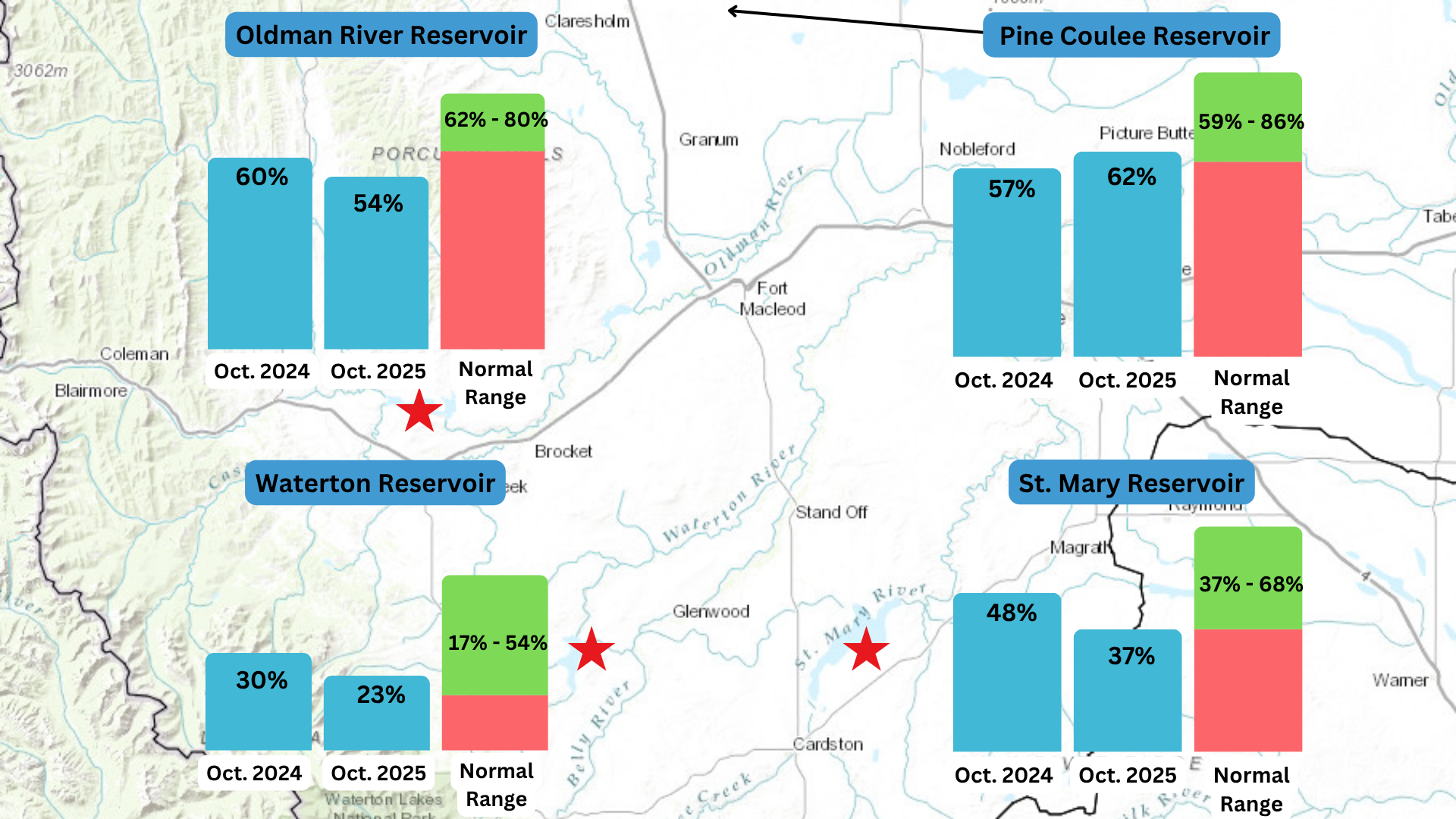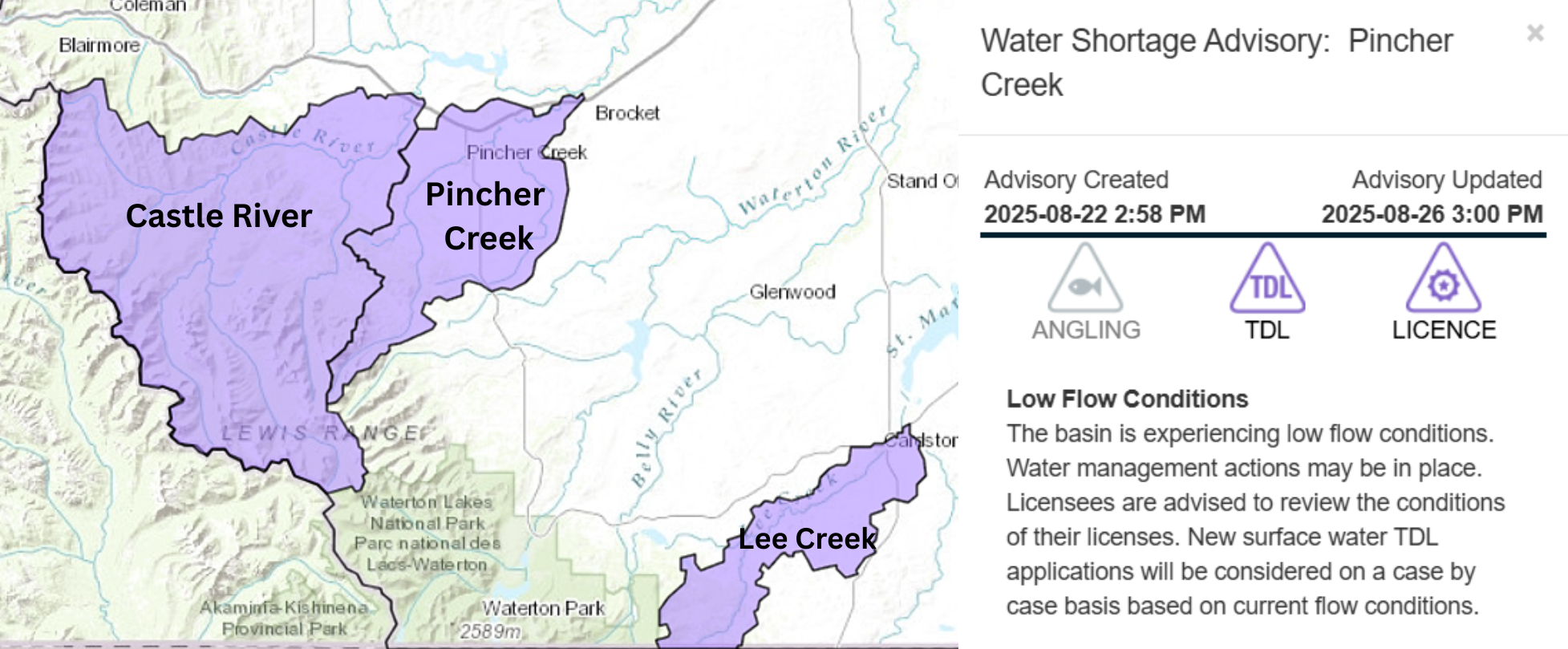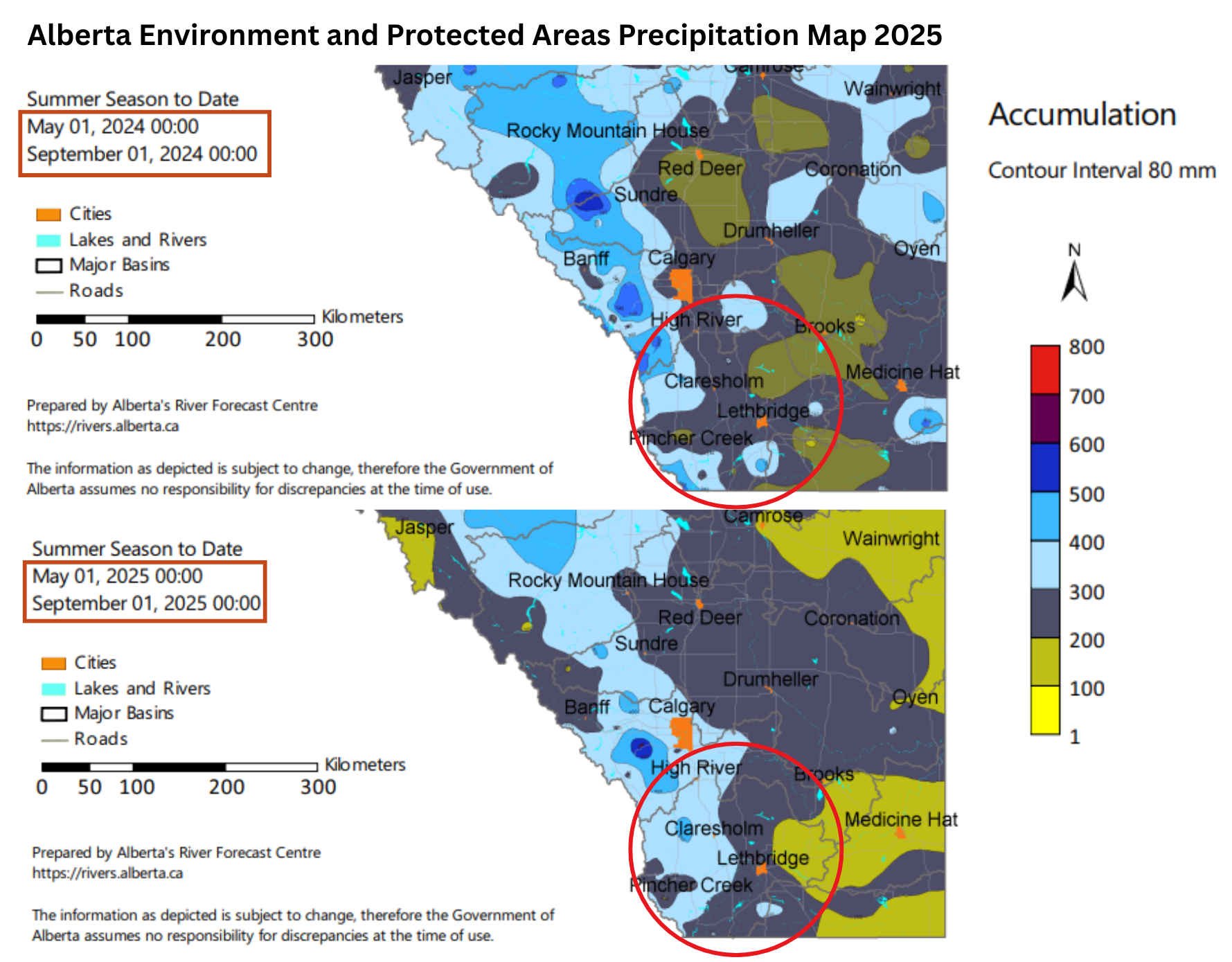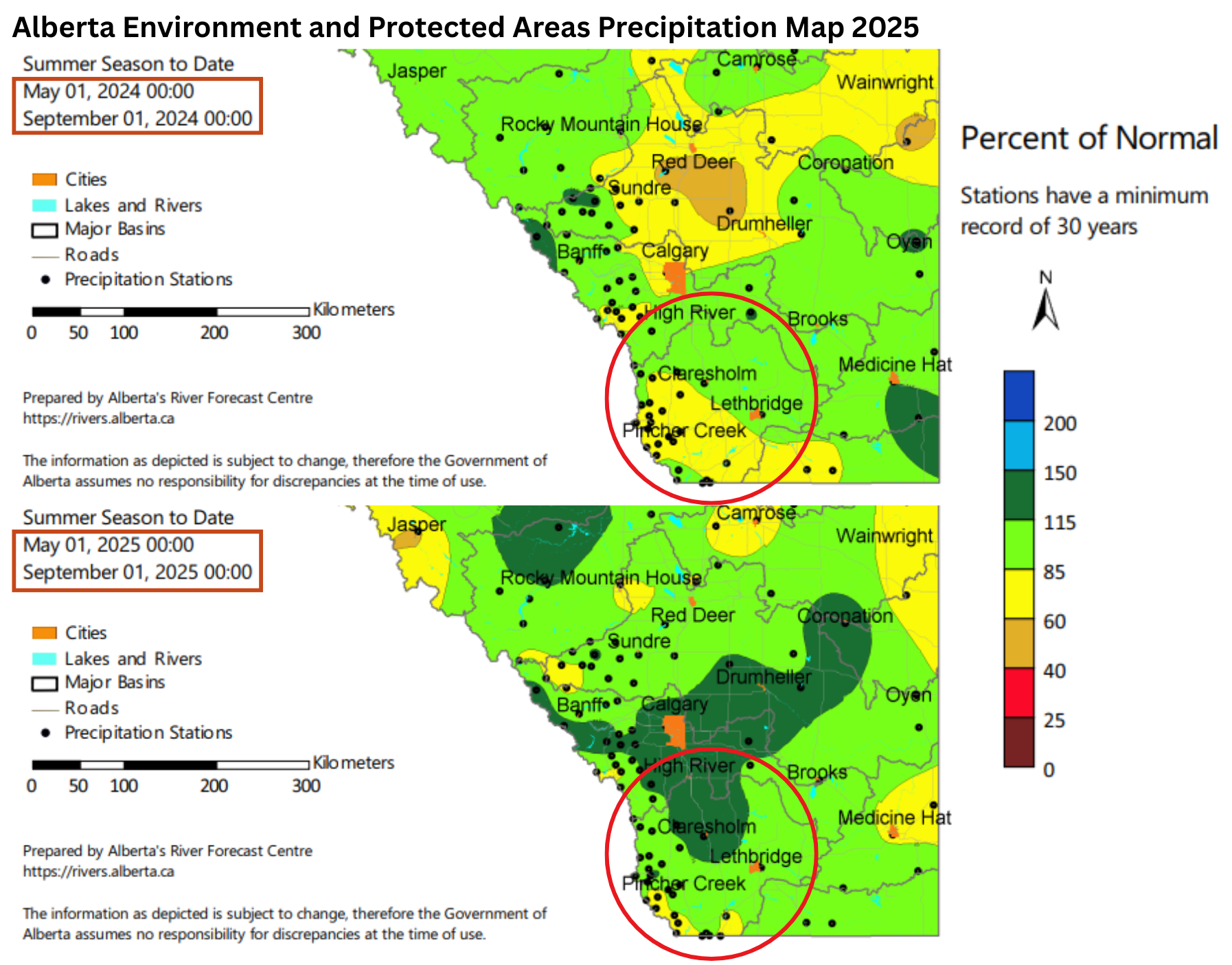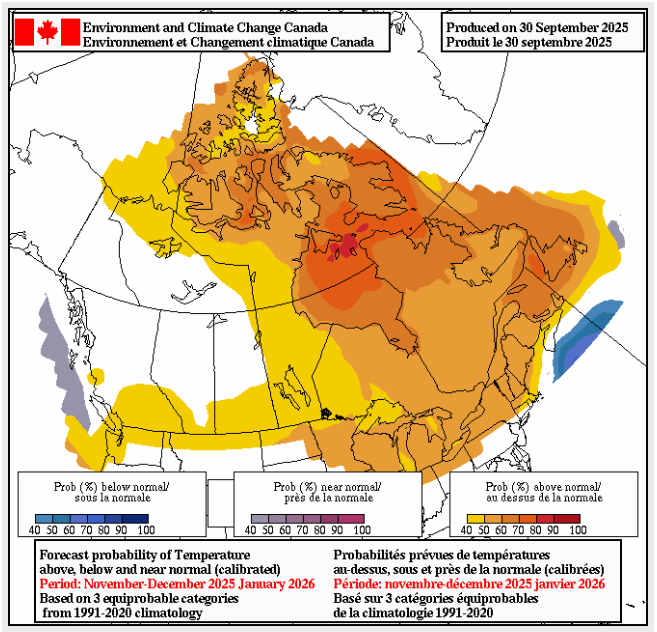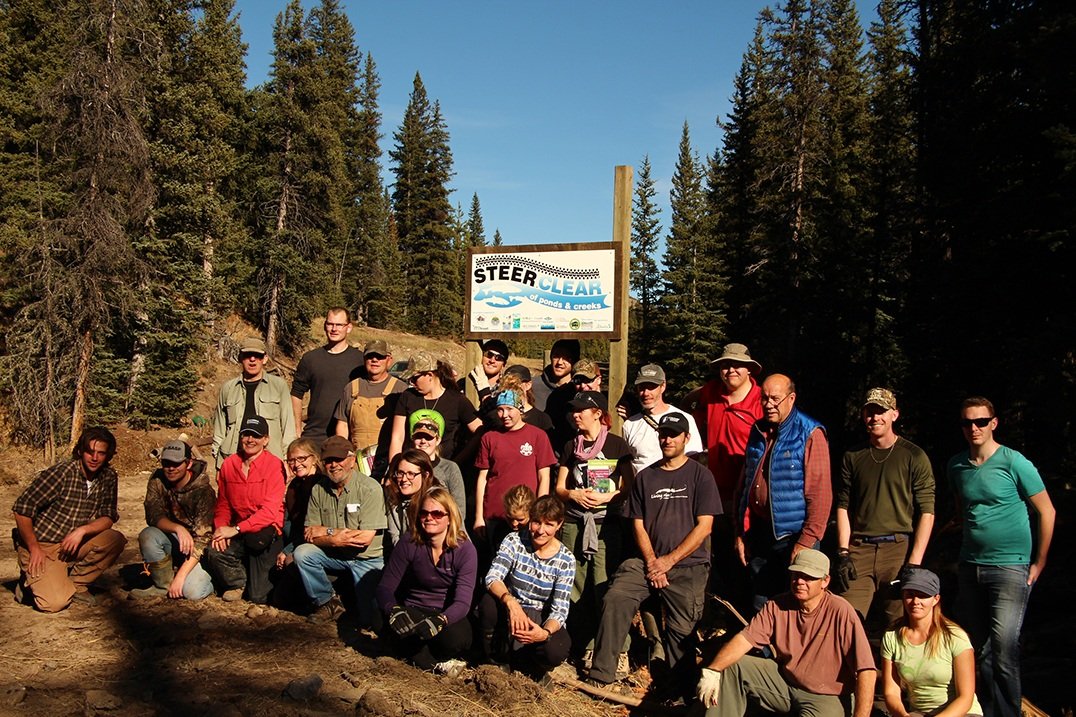Banner photo by Kallie Val-Zehan Desruisseaux. Blog by Watershed Stewardship Assistant Chantel Youmans.
With fall in full swing around us and winter starting to nip at its heels, it’s once again time to take a look at how the Oldman watershed fared over the summer, and what we might expect in the upcoming snowy months. Our unusually rainy July brought some much-needed mid-summer moisture to the prairies, bolstering crop production for the year, and while some water advisories are in place, no Water Sharing Agreements were activated this year. Precipitation trends throughout Alberta continue to be on the drier side, but the Oldman watershed is currently in drought Stage 0, indicating adequate water supply. Reservoir levels throughout the watershed are fair, and stream flows continue to be adequate or better as Alberta’s drought conditions ease slightly. With a La Niña forecast on the horizon potentially ushering in a wet winter, let's all keep our fingers crossed for a healthy snowpack to bring us into spring!
Current Drought Condition
Since mid-September, Alberta Environment and Parks has categorized the Oldman River Basin as being in drought Stage 0, which means basin drought conditions aren’t occurring. In this drought stage, water supply outlooks show low risk of water shortages and water management actions are limited. While the basin as a whole isn’t currently in a drought, it is important to note that pockets of the watershed are still abnormally dry and are bordering on drought conditions.
As a province, the picture is looking a little drier. The Canadian Drought Monitor report, which characterizes drought by region rather than watershed, for September shows that dry conditions have continued to spread across Alberta, with more areas in either ‘abnormally dry’ or ‘moderate drought’ conditions compared to September of 2024. It was a dry month: the National Agroclimate Risk Report indicates that most of Alberta received 40% or less of the average precipitation in September. Thanks to the above average rainfall in the summer, however, agricultural yields remain strong and are projected to meet or exceed the 5-year average.
The Canadian Drought Monitor provides real time and historic maps to compare drought intensity across the various regions of Canada. From this graphic, we can see that drought conditions have intensified in the central and northern portions of the province as larger areas begin to experience extreme drought, while central and southern areas remain a mix of abnormally dry to severe drought. Map adapted from Agriculture and Agri-Food Canada, 2025.
Water Supply at a Glance
Reservoir levels this year are lower than the last time we checked in; while water levels in general remain at or slightly below normal ranges, the total amount in reservoirs has decreased. Of the 15 reservoirs in the watershed, 3 are currently below normal range, including the Oldman reservoir, and four are above normal. On average, the reservoirs are at 58% of total capacity as of Oct. 20, a notable decrease from an average of 70% of total capacity in October 2024.
The water levels in the four major storage reservoirs in the Oldman watershed (Oldman, Waterton, St. Mary, and Pine Coulee reservoirs) in October of 2024 and 2025, as well as the normal ranges for this time of the year. We can see that in 2025, three of these reservoirs are on the low end of their normal range, while one (the Oldman River Reservoir) is below normal. The major reservoirs are marked by red stars or an arrow. Infographic adapted from Alberta Rivers.
The number of active Water Shortage Advisories (WSAs) in the watershed has decreased from six to three since 2024, although all three of the currently affected areas were also under advisory last year. During an advisory, the provincial government may pause Temporary Diversion Licenses (TDL), which are licenses that allow holders to divert surface and/or ground level water from water bodies, and new TDLs are considered only on a case-by-case basis. There may also be changes to term licensed withdrawals, which means that senior water license holders can begin to make priority calls to ensure their water needs are met according to Alberta’s ‘First in Time, First in Right’ water policy. With a WSA, angling advisories can also be put in place to limit stresses on fish populations.
Castle River, Pincher Creek, and Lee Creek are under Water Shortage Advisories since August 2025. All three areas had WSAs in 2024 as well. Map adapted from Alberta Rivers.
Areas with active WSAs are reporting stream flows that are 70% or lower of defined thresholds, with the level of Lee Creek near Cardston at only 27% what it needs to be. Instream objectives and water management thresholds provide guidelines for particular areas of a river or stream, defining the minimum amount of water that’s necessary to support the needs of both water users and the aquatic environment. When flows dip below these thresholds, which we’re seeing in areas with active WSAs, the aquatic environment becomes stressed and there is less water for the people and ecosystems that need it.
Summer Rains and Soil Moisture
This summer, it felt like we received a year’s worth of rain in a month! While precipitation values weren’t quite that dramatic, we did receive an exceptional amount of rain in mid-summer. In June 2025 alone, we received 92.7 mm! To put that in perspective, from the beginning of June to the end of July 2024, we had 58.9 mm of rainfall. Despite the generous summer rain, yearly precipitation levels have actually decreased from 2024 to 2025; by the end of October 2024, 414.7 mm of rain had fallen, while so far in 2025 we’ve only had 296.4 mm.
Precipitation maps from the summer season of 2024 (top) and 2025 (bottom). The western portion of the watershed had more precipitation in summer 2025, while the central and eastern part remained the same or had a slight decrease in summer precipitation. Maps adapted from Alberta’s River Forecast Centre.
Rainfall in our region for the summer of 2025 was generally above the 30-year average, as seen in the graphic below. Summer precipitation values for the watershed ranged from 85% to 150% of the normal range, an increase from 2024 where a large chunk of the watershed saw only 60% to 85% of normal precipitation. An important note here is that these values are for May 1–Sept. 1, which means we had a rainier summer this year compared to 2024 and the 30-year average, but, as we mentioned above, overall precipitation levels for the entire year have decreased.
Precipitation maps from the summer season of 2024 (top) and 2025 (bottom). Thanks to a rainy June, a large portion of the watershed received precipitation exceeding the 30-year normal values in 2025. Maps adapted from Alberta’s River Forecast Centre.
Despite all that mid-summer rain, soil moisture remains low throughout most of the province. Much of the Oldman watershed is ranging from moderately low to extremely dry, with the exception of a few pockets of ‘near normal’ conditions near Pincher Creek. Many areas are experiencing low soil moisture conditions that should only occur once every 3–6 years, with some areas like Lethbridge experiencing lows that we would only expect to see every 25–50 years. The high soil moisture southern Alberta saw last year can likely be explained by the almost 90 mm of rain that fell in August and September of 2024, a surprise occurrence for our neck of the woods. Comparatively, from August to mid-October of this year, we’ve only received 30 mm, contributing to the ongoing dry conditions.
Soil moisture levels in October 2024 (top) and October 2025 (bottom). Following a fairly moist fall in 2024, much of the Oldman watershed (circled above) is once again facing very dry soil conditions in 2025. Map adapted from Alberta Climate Information Service.
What to Expect from Winter
Much of Alberta doesn’t yet have a winter forecast, but early predictions indicate that, despite La Niña’s cooling effects, southern Alberta and the Oldman watershed may be in for a warm winter. Map: Environment and Climate Change Canada.
La Niña conditions have been emerging since September and are expected to continue into February 2026, before transferring into more neutral conditions in late winter or early spring, per the National Oceanic and Atmospheric Association. What this means is that we could have a cooler winter with more snow, though the current forecast indicates that this year’s La Niña effect may be light, limiting the cool temperatures and precipitation expected. In addition to the El Niño/Southern Oscillation (ENSO) forecast, Environment and Climate Change Canada is predicting a 40% chance for above average temperatures from November 2025 to January 2026. The Oldman watershed is heavily reliant on snowpack (and spring rains) in our headwaters to recharge water levels during the spring melt; lots of snow is a pain when you’re clearing your driveway in January, but it contributes greatly to a greener spring/summer, healthier crop yields, and fuller rivers and streams.
Looking ahead: Alberta’s Next Steps in Drought Management
Efforts are still underway to reduce the impact of continuing drought conditions on Albertans. In May 2024, the government of Alberta released a provincial Drought Response Plan, which aims to protect the health and safety of Albertans, minimize the social, economic, and environmental impacts of drought, and provide adaptive response structures for future droughts. The plan also details the steps that the provincial Ministry of Environment and Protected Areas may take to address a variety of drought conditions. Since its release, the plan has been revised, including updates to the definition of the drought stages as well as risk assessment and drought response protocols. Read the revised plan here.
A study is also currently underway to determine if a dam and storage reservoir could be constructed on the Belly River, which could improve water security for crop irrigation. Possibilities for improving the canal and water flow between the Waterton and St.Mary reservoirs are also being explored. Meanwhile, applications are being accepted for the Drought and Flood Protection Program, a multi-year grant program launched in 2024 to help fast-track improvements to community drought and flood resilience. Grant recipients are eligible for up to $10 million in funds per project to relocate, improve, and construct infrastructure that will help lessen drought impacts.
Final Thoughts
This past year brought a light reprieve from the stubborn drought conditions that the province has faced recently, with refreshing summer rains providing a much-needed recharge to the Oldman region’s streams and reservoirs. Abnormally dry conditions remain present, but we aren’t experiencing basin drought conditions, and the current water supply outlook indicates that needs are being met for the majority of water users within the Oldman watershed. Despite soil moisture reserves beginning to dwindle in late summer and fall, Alberta still saw an exceptional crop yield this year, ensuring our plates will be full for another season. With any luck, La Niña will bring ample snow to further boost our water supply and start 2026 on even better terms!
As Alberta continues to experience periodic dry spells, it’s likely we’ll experience drought in the future. Living in a semi-arid region, prone to water shortages and drought, means that effective water use remains important to protecting our precious liquid resources. By continuing to follow water-wise recommendations and being mindful of our water use and current conditions, we all contribute to keeping our communities and watershed healthy, resilient, and vibrant for years to come.
Like all OWC’s blogs, this post was written by a real live human, without the use of generative AI.



